Adopting fuel-saving technologies is essential for the commercial trucking industry to enhance efficiency, reduce operational costs, and meet environmental standards. We’ve shared the latest technology.
Revolutionizing Fuel Efficiency: Top Technologies for Commercial Trucks
 In the commercial trucking industry, fuel expenses constitute a significant portion of operational costs. With rising fuel prices and increasing environmental regulations, fleet operators and truck drivers are constantly seeking ways to improve fuel efficiency. Advances in technology have paved the way for innovative solutions designed to save fuel and reduce the carbon footprint of commercial trucks. Here’s a look at some of the most effective fuel-saving technologies available today.
In the commercial trucking industry, fuel expenses constitute a significant portion of operational costs. With rising fuel prices and increasing environmental regulations, fleet operators and truck drivers are constantly seeking ways to improve fuel efficiency. Advances in technology have paved the way for innovative solutions designed to save fuel and reduce the carbon footprint of commercial trucks. Here’s a look at some of the most effective fuel-saving technologies available today.
#1 Telematics and Fleet Management Systems
Telematics and fleet management systems are at the forefront of fuel-saving technologies. These systems utilize GPS and onboard diagnostics to monitor truck performance, driver behaviour, and route efficiency. By analyzing data on speed, idling time, braking, and acceleration, fleet managers can identify areas for improvement and implement strategies to optimize fuel use. Real-time feedback and driver coaching tools help drivers adopt fuel-efficient driving habits, resulting in significant fuel savings.
If you’re interested in more information, check out this article by SafetyCulture – it outlines the best fleet telematics software of 2024.
#2 Aerodynamic Enhancements
Aerodynamic drag is a major contributor to fuel consumption in commercial trucks, especially at highway speeds. Various aerodynamic enhancements can help reduce drag and improve fuel efficiency:
- Trailer Skirts: These panels, installed along the sides of the trailer, help to smooth airflow and reduce drag.
- Boat Tails: Devices attached to the rear of the trailer that taper the airflow and minimize turbulence.
- Roof Fairings: Mounted on the tractor's roof, these fairings direct airflow over the trailer, reducing resistance.
- Side Fairings: Placed on the sides of the tractor, these fairings smooth out the airflow around the vehicle.
#3 Automatic Tire Inflation Systems (ATIS)
Proper tire inflation is crucial for fuel efficiency. Under-inflated tires increase rolling resistance, leading to higher fuel consumption. Automatic Tire Inflation Systems (ATIS) continuously monitor and maintain optimal tire pressure, ensuring consistent fuel savings and reducing the risk of tire blowouts and uneven wear.
#4 Low Rolling Resistance Tires
Low-rolling resistance tires are designed to minimize the energy lost as tire rolls, thereby improving fuel efficiency. These tires use advanced materials and tread patterns to reduce friction and heat build-up, contributing to lower fuel consumption without compromising on performance or safety.
#5 Predictive Cruise Control
Predictive cruise control systems use GPS and topographical data to anticipate changes in road conditions, such as hills and curves. By adjusting speed and gear selection proactively, these systems optimize fuel use by maintaining a steady speed and minimizing unnecessary acceleration and braking.
#6 Engine Idle Reduction Technology
Idling is a significant source of fuel waste in commercial trucks. Engine idle reduction technologies, such as automatic engine shutdown systems and auxiliary power units (APUs), help reduce idle time by providing power for heating, cooling, and other functions without running the main engine. This not only saves fuel but also reduces engine wear and emissions.
#7 Diesel Particulate Filters (DPF) and Selective Catalytic Reduction (SCR)
While primarily designed to reduce emissions, Diesel Particulate Filters (DPF) and Selective Catalytic Reduction (SCR) systems can also contribute to fuel efficiency. These technologies ensure that the engine operates more efficiently by maintaining optimal combustion conditions and reducing back pressure, leading to improved fuel economy.
#8 Advanced Engine Technologies
Modern engines are equipped with advanced technologies aimed at maximizing fuel efficiency. Turbocharging, variable valve timing, and direct fuel injection are examples of innovations that enhance engine performance and fuel economy. Additionally, new hybrid and electric drivetrains are emerging as viable options for certain applications, offering significant fuel savings and emissions reductions.
#9 Lightweight Materials
Reducing vehicle weight is a straightforward way to improve fuel efficiency. The use of lightweight materials such as aluminum, high-strength steel, and composites in truck construction can significantly lower the overall weight of the vehicle, reducing the amount of energy required to move it and thereby improving fuel economy.
#10 Smart Drive Technologies
Smart drive technologies integrate various systems to optimize overall vehicle performance. These include adaptive transmission systems that automatically select the most fuel-efficient gear, regenerative braking systems that capture and store energy during braking, and intelligent power management systems that balance power distribution to different vehicle components.
